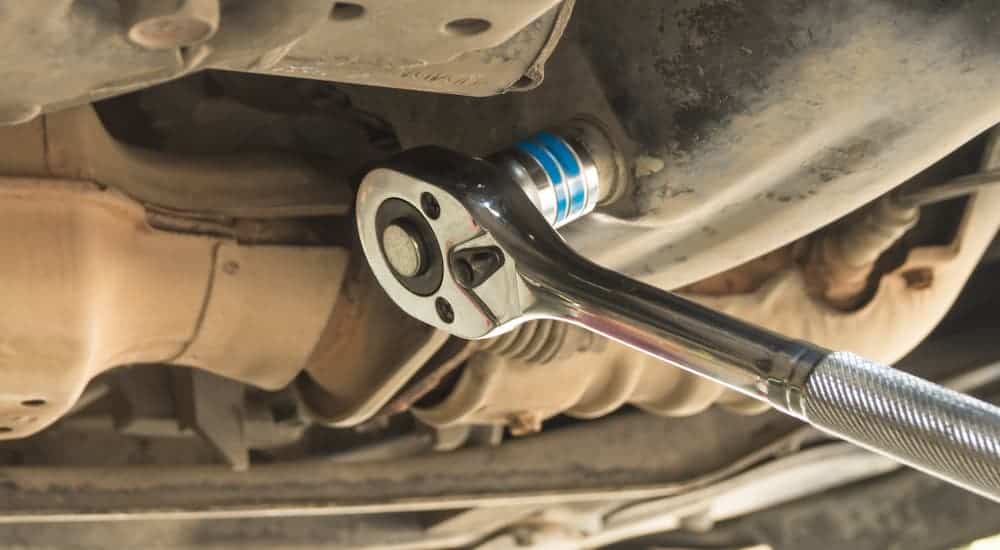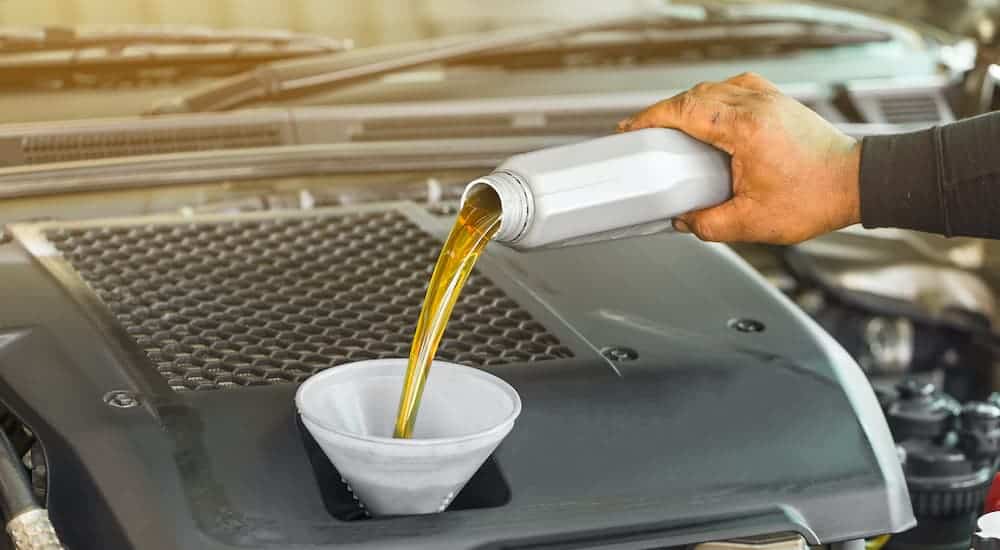Oil changes can get pricey if you’re going to a garage, and the fact of the matter is that you can do it yourself quickly and easily for a much lower price. If you want to perform your own oil change for your used Ram diesel, we’re here to help. Changing the oil on a diesel Ram truck may feel overwhelming if you’re accustomed to gasoline engines but rest assured that it’s not that different. From 2013 models to 2019 models, the oil changing process is the same, but it’s different on 2020 models. We’ll divide it up so you can follow the guide that matches your truck’s year.
Getting Started
There are a few different ways to get to your oil filter, but the easiest way is to go through the passenger side using a socket. You’ll need 10.5 quarts of oil and one MOPAR filter, along with an oil pan for draining the old oil. Be sure to park on level ground and apply your emergency brake. Ram trucks are already pretty high, but if you want extra room to maneuver, it can’t hurt to use a jack or put your truck on ramps. Just make sure you take safety precautions when doing so.
Additionally, be cautious when draining the old oil if you’ve recently driven anywhere. It’s best to wait at least 20 to 30 minutes after driving before changing the oil to prevent burns and injuries. Conversely, if your engine is cold, starting your vehicle for a few short minutes will make it easy to drain without being scolding hot. Your engine temperature should be around 100 degrees Fahrenheit.
Steps to Changing the Oil in 2013 to 2019 Diesel Ram Trucks
First, drain the old oil. Do this by removing the oil plug with a 13-millimeter socket. Give it time to drain out as much of the old oil as possible. You can use a magnet to retrieve your oil plug if you want to avoid contact with hot oil. Next, remove the oil filter with your 13-millimeter socket by loosening it up and pulling it out. To avoid getting oil everywhere, place paper towels in a large Ziplock freezer bag, and wrap this around the oil filter before removal. You can also purchase an oil filter cap off tool, which helps when removing and replacing the filter.
Now, it’s time to replace the filter. Make sure any excess older oil is drained from the filter. Then, cover the new O-ring seal with fresh oil, and screw the filter back on, making sure it’s properly threaded. Replace the housing cap, and don’t forget to readjust the torque. The cap contains instructions to tighten it back to 18 lb-ft. Make sure the drain plug is still working properly, then reinstall it.
Now, let’s put the oil in. First, remove the oil cap located under the hood. Unlike other vehicles, it’s simple to locate the oil cap in the Ram. You won’t have to move anything out of the way. Using a funnel, put 10.5 quarts of diesel engine oil into the opening, then replace the oil cap once this is complete. Using a dipstick, check to make sure the oil is at the appropriate level, then start your Ram to check its oil pressure and check for leaks while letting the new oil circulate for a few minutes. Overall, changing the oil on a used Ram truck is simple and much more affordable than taking it to an oil change station.

Variations for the 2020 Model
While all used Ram trucks are similar, they do undergo changes over time. The 2020 Ram has a different oil filter, and it requires a different amount of oil than the 2014 to 2019 models. The 2020 model only requires 8.5 quarts of oil, versus 10.5 in previous models. Further, many owners claim that a cross member is in the way when draining the oil, resulting in messy spills and difficulty accessing the oil plug. That’s not necessarily the case.
While it does make things a bit more crowded, it’s still pretty simple to access the area. If you’re using a drain valve, just be sure to use one with a shorter nipple, and you’ll be fine. Using cardboard or something solid yet flexible to direct the oil into your drain pan is an even cheaper way to help prevent messes if you don’t want to purchase a drain valve, but drain valves are recommended for Ram trucks.
On the 2020 model, you’ll need a half-inch socket to remove the drain plug. Additionally, the new Gen-3 filters are made as one solid piece rather than divided, but there are some Gen-3 filters that can be taken apart. It seems to vary. Now, you’ll need a 27-millimeter socket to tighten and remove your filter. Be sure not to over tighten it. When replacing the O-rings on the Gen-3 filters, there are several threads, so make sure the two O-rings are in the correct spots to prevent leakage.
Types of Oil to Use
There are many different types of oil that you can use on used Ram trucks, and they vary depending on your desired outcome. Synthetic oils are more costly, and rightfully so, due to how much healthier they are for your engine. Using synthetic oils can keep you on the road for 5,000 to 10,000 miles, and it’s better for your engine long-term since it’s better at filtering out particles. It’s also much more eco-friendly than its synthetic blend counterpart.
Now that we know the ideal oil types let’s look at the best brands that you can use for a used Ram diesel truck. Let’s look at synthetic oils first. The one that people use most is Valvoline’s Premium Blue SAE 15W-40 engine oil. Cummins recommends it, and it’s said to be best for cold starts, high temperatures, and EcoDiesel engines. There’s also Shell’s Rotella T6 5W-40 oil, which is a bit more affordable than Valvoline’s variant. For lower temperature engines, Shell’s 10W-30 works well.
Now for synthetic blend options. Valvoline’s Synthetic Blend SAE 5W-30 is a great place to start. It’s much cheaper than its full synthetic cousin. While a synthetic blend may not be as efficient as a fully synthetic oil, Valvoline’s oil has great ratings, and this synthetic blend oil is designed to last longer than most other brands. Further, Shell’s Rotella T5 SAE 15W-40 blend is better for low temps than its competitors. Whatever route you choose, these oils should provide you with the best results for your used Ram diesel truck.

Oil Change Frequency
You’re probably wondering how often you should be changing the oil on a Ram diesel truck. With synthetic oils, you may not need to get an oil change more than once a year or until 10,000-miles. However, if you’re using synthetic blend oils, you’ll need to change your oil every 3,000 to 5,000 miles. While it’s cheaper short-term, the long-term effects are often worth using synthetic oil. Waiting too long to get your oil changed can result in engine damage, thanks to all the extra work that goes into pushing sludgy oil and losing proper lubrication.
Try It Yourself
So, as you can see, changing your oil in your Ram diesel truck yourself is not as difficult as it seems. The hardest part is choosing the right kind of oil for your vehicle and knowing where all the parts are. However, that little bit of a learning curve will lead to a greater reward as you will save money on oil by buying it yourself, and you’ll save even more by not paying to have someone else change it. Also, you can change your oil on your schedule rather than some else’s. It’s time to become a DIY oil change expert.

